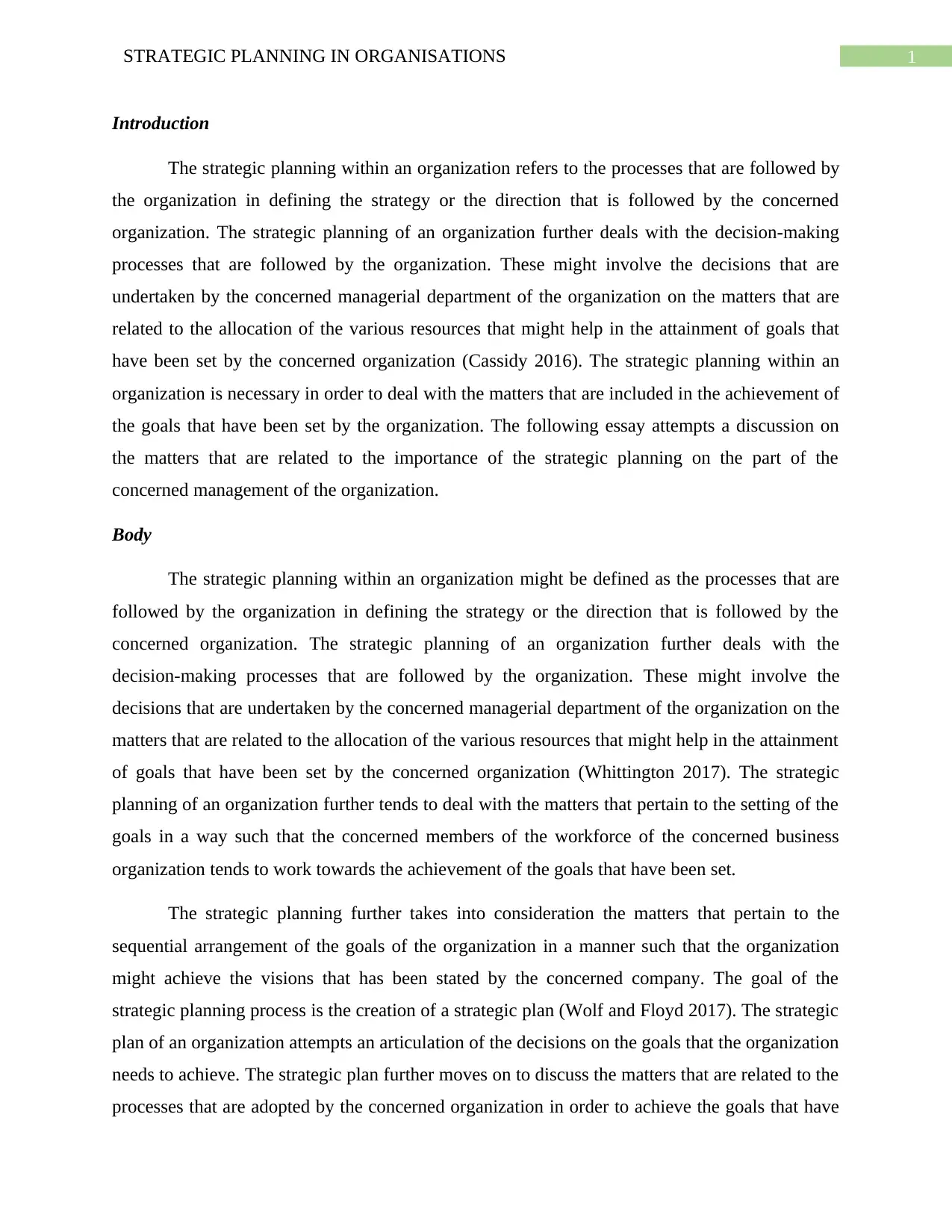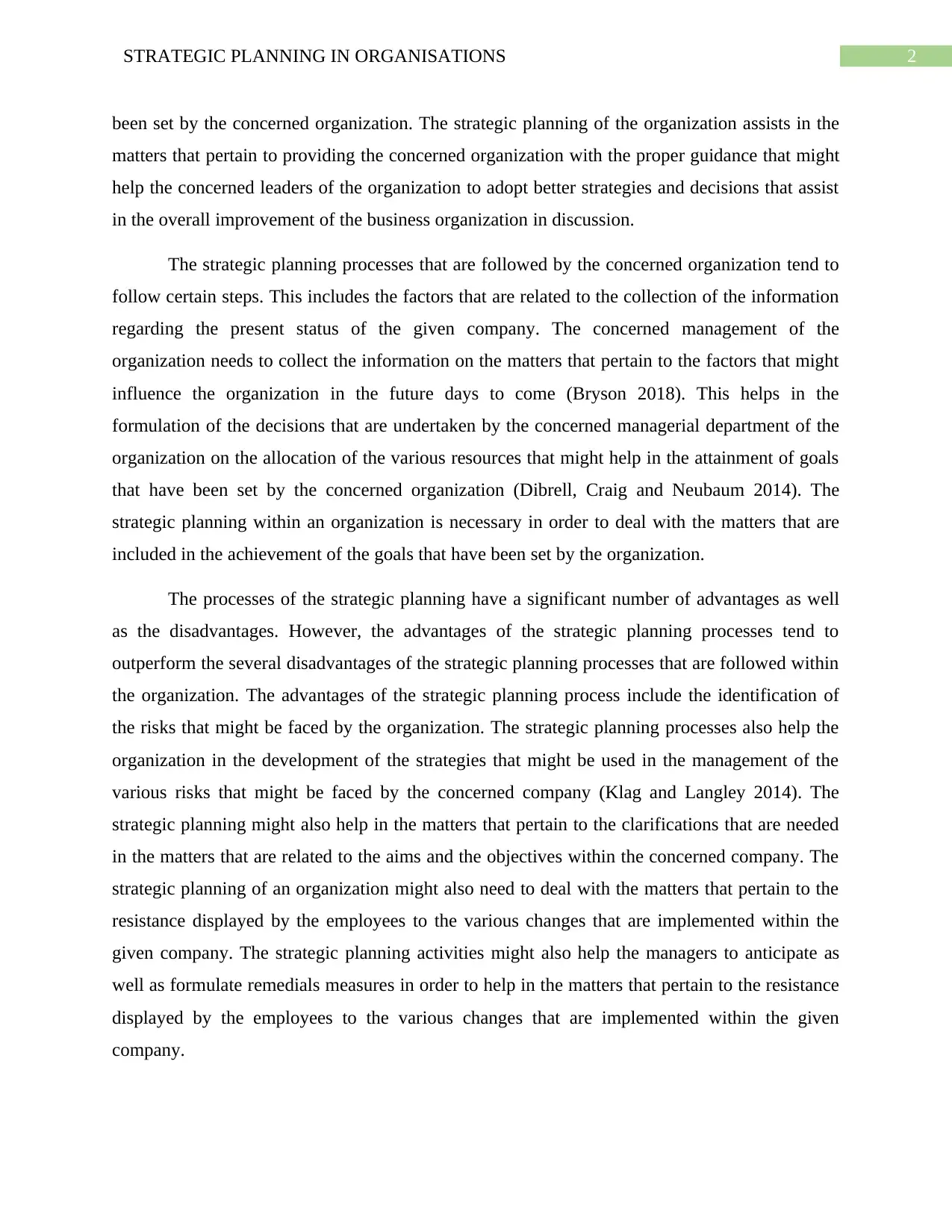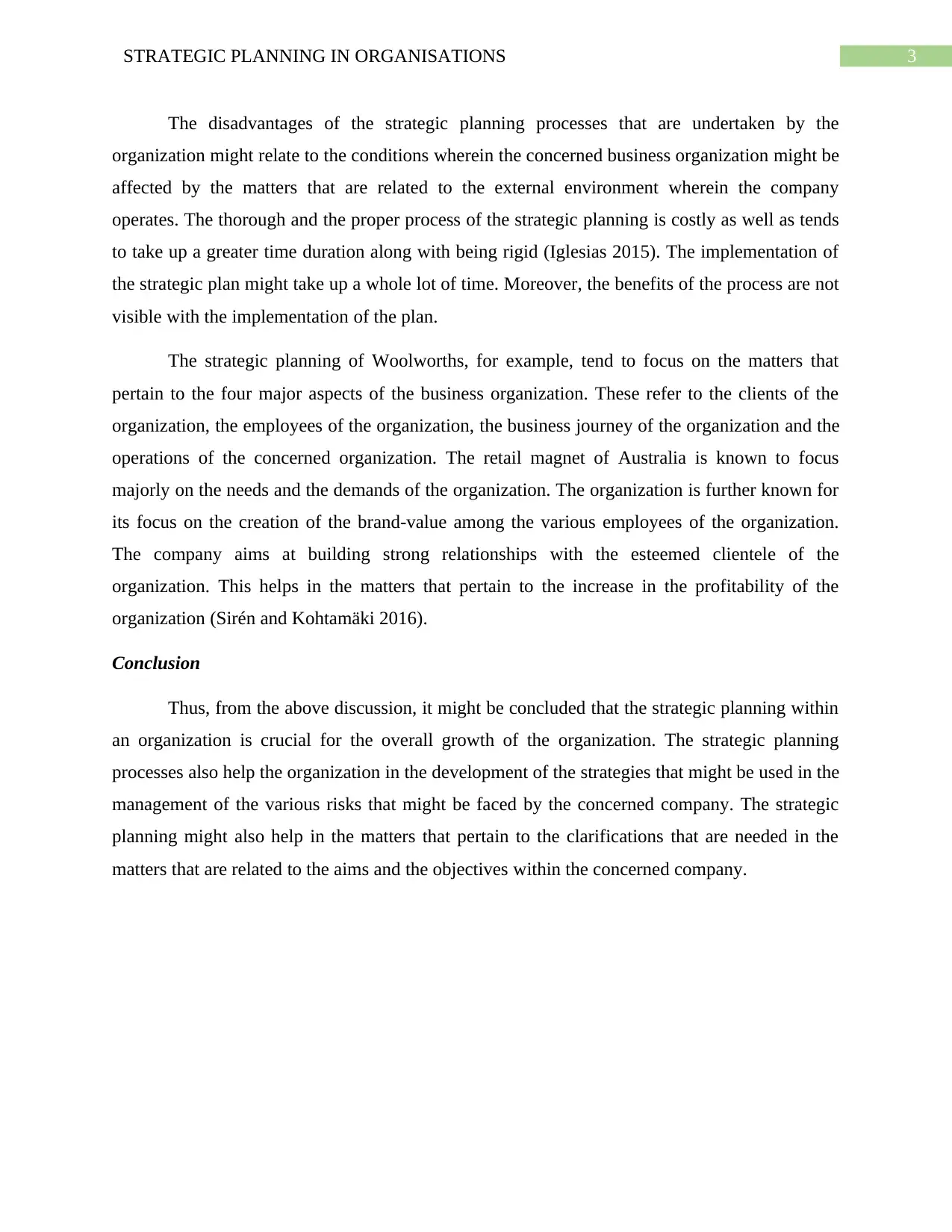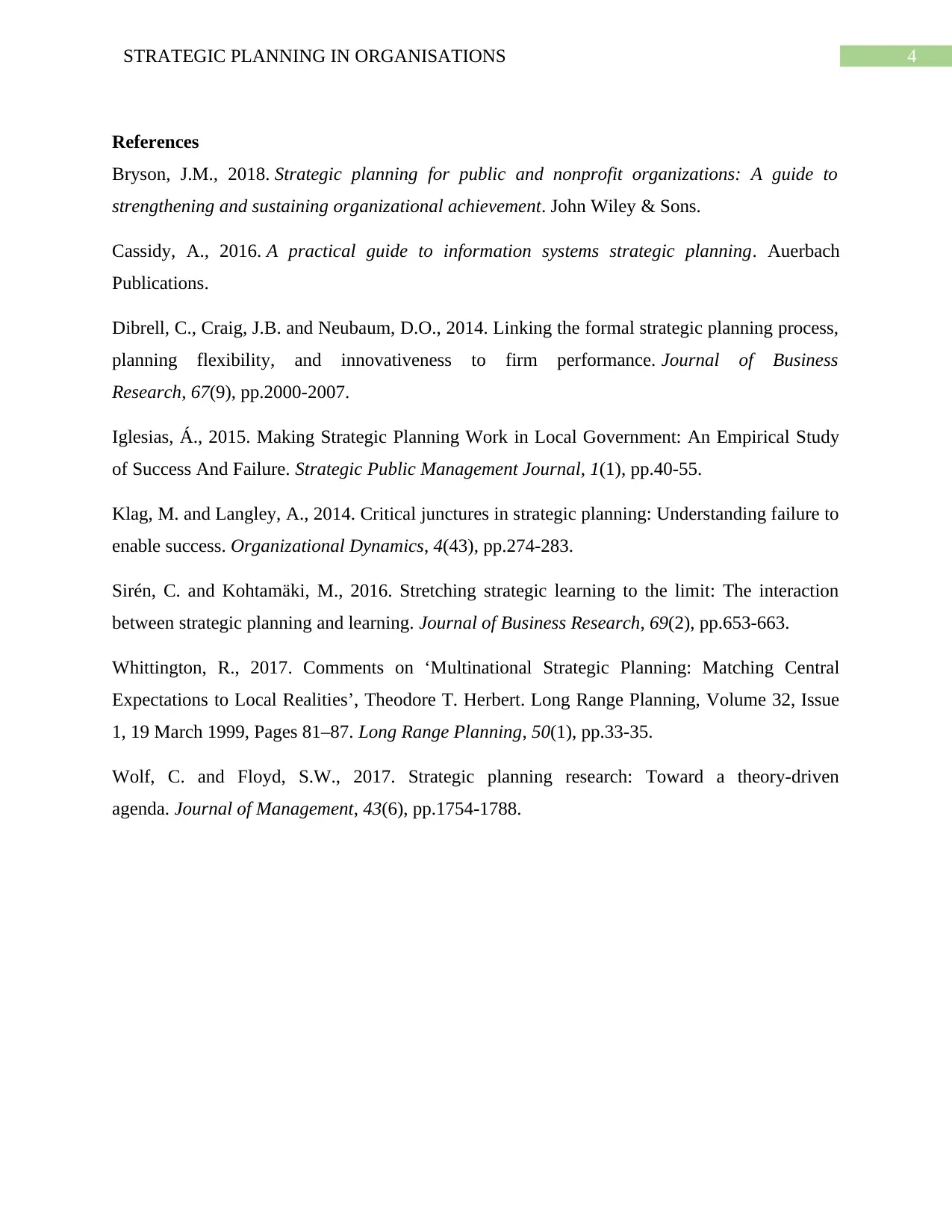Strategic Planning in Organisations - BBA102 Principles of Management
VerifiedAdded on 2023/06/08
|5
|1517
|204
Essay
AI Summary
This essay discusses the importance of strategic planning in organizations, defining it as the process of setting direction and making decisions about resource allocation to achieve organizational goals. It highlights the role of strategic planning in setting and sequencing goals to align with the company's vision. The essay also covers the steps involved in strategic planning, including information gathering and risk identification, and discusses the advantages and disadvantages of the process. It emphasizes that the benefits of strategic planning, such as risk management and goal clarification, generally outweigh the drawbacks, like time consumption and rigidity. An example of Woolworths' strategic planning approach is provided, focusing on clients, employees, business journey, and operations. The essay concludes that strategic planning is crucial for organizational growth and success.

Running head: STRATEGIC PLANNING IN ORGANISATIONS
STRATEGIC PLANNING IN ORGANISATIONS
Name of the Student
Name of the University
Author Note
STRATEGIC PLANNING IN ORGANISATIONS
Name of the Student
Name of the University
Author Note
Paraphrase This Document
Need a fresh take? Get an instant paraphrase of this document with our AI Paraphraser

1STRATEGIC PLANNING IN ORGANISATIONS
Introduction
The strategic planning within an organization refers to the processes that are followed by
the organization in defining the strategy or the direction that is followed by the concerned
organization. The strategic planning of an organization further deals with the decision-making
processes that are followed by the organization. These might involve the decisions that are
undertaken by the concerned managerial department of the organization on the matters that are
related to the allocation of the various resources that might help in the attainment of goals that
have been set by the concerned organization (Cassidy 2016). The strategic planning within an
organization is necessary in order to deal with the matters that are included in the achievement of
the goals that have been set by the organization. The following essay attempts a discussion on
the matters that are related to the importance of the strategic planning on the part of the
concerned management of the organization.
Body
The strategic planning within an organization might be defined as the processes that are
followed by the organization in defining the strategy or the direction that is followed by the
concerned organization. The strategic planning of an organization further deals with the
decision-making processes that are followed by the organization. These might involve the
decisions that are undertaken by the concerned managerial department of the organization on the
matters that are related to the allocation of the various resources that might help in the attainment
of goals that have been set by the concerned organization (Whittington 2017). The strategic
planning of an organization further tends to deal with the matters that pertain to the setting of the
goals in a way such that the concerned members of the workforce of the concerned business
organization tends to work towards the achievement of the goals that have been set.
The strategic planning further takes into consideration the matters that pertain to the
sequential arrangement of the goals of the organization in a manner such that the organization
might achieve the visions that has been stated by the concerned company. The goal of the
strategic planning process is the creation of a strategic plan (Wolf and Floyd 2017). The strategic
plan of an organization attempts an articulation of the decisions on the goals that the organization
needs to achieve. The strategic plan further moves on to discuss the matters that are related to the
processes that are adopted by the concerned organization in order to achieve the goals that have
Introduction
The strategic planning within an organization refers to the processes that are followed by
the organization in defining the strategy or the direction that is followed by the concerned
organization. The strategic planning of an organization further deals with the decision-making
processes that are followed by the organization. These might involve the decisions that are
undertaken by the concerned managerial department of the organization on the matters that are
related to the allocation of the various resources that might help in the attainment of goals that
have been set by the concerned organization (Cassidy 2016). The strategic planning within an
organization is necessary in order to deal with the matters that are included in the achievement of
the goals that have been set by the organization. The following essay attempts a discussion on
the matters that are related to the importance of the strategic planning on the part of the
concerned management of the organization.
Body
The strategic planning within an organization might be defined as the processes that are
followed by the organization in defining the strategy or the direction that is followed by the
concerned organization. The strategic planning of an organization further deals with the
decision-making processes that are followed by the organization. These might involve the
decisions that are undertaken by the concerned managerial department of the organization on the
matters that are related to the allocation of the various resources that might help in the attainment
of goals that have been set by the concerned organization (Whittington 2017). The strategic
planning of an organization further tends to deal with the matters that pertain to the setting of the
goals in a way such that the concerned members of the workforce of the concerned business
organization tends to work towards the achievement of the goals that have been set.
The strategic planning further takes into consideration the matters that pertain to the
sequential arrangement of the goals of the organization in a manner such that the organization
might achieve the visions that has been stated by the concerned company. The goal of the
strategic planning process is the creation of a strategic plan (Wolf and Floyd 2017). The strategic
plan of an organization attempts an articulation of the decisions on the goals that the organization
needs to achieve. The strategic plan further moves on to discuss the matters that are related to the
processes that are adopted by the concerned organization in order to achieve the goals that have

2STRATEGIC PLANNING IN ORGANISATIONS
been set by the concerned organization. The strategic planning of the organization assists in the
matters that pertain to providing the concerned organization with the proper guidance that might
help the concerned leaders of the organization to adopt better strategies and decisions that assist
in the overall improvement of the business organization in discussion.
The strategic planning processes that are followed by the concerned organization tend to
follow certain steps. This includes the factors that are related to the collection of the information
regarding the present status of the given company. The concerned management of the
organization needs to collect the information on the matters that pertain to the factors that might
influence the organization in the future days to come (Bryson 2018). This helps in the
formulation of the decisions that are undertaken by the concerned managerial department of the
organization on the allocation of the various resources that might help in the attainment of goals
that have been set by the concerned organization (Dibrell, Craig and Neubaum 2014). The
strategic planning within an organization is necessary in order to deal with the matters that are
included in the achievement of the goals that have been set by the organization.
The processes of the strategic planning have a significant number of advantages as well
as the disadvantages. However, the advantages of the strategic planning processes tend to
outperform the several disadvantages of the strategic planning processes that are followed within
the organization. The advantages of the strategic planning process include the identification of
the risks that might be faced by the organization. The strategic planning processes also help the
organization in the development of the strategies that might be used in the management of the
various risks that might be faced by the concerned company (Klag and Langley 2014). The
strategic planning might also help in the matters that pertain to the clarifications that are needed
in the matters that are related to the aims and the objectives within the concerned company. The
strategic planning of an organization might also need to deal with the matters that pertain to the
resistance displayed by the employees to the various changes that are implemented within the
given company. The strategic planning activities might also help the managers to anticipate as
well as formulate remedials measures in order to help in the matters that pertain to the resistance
displayed by the employees to the various changes that are implemented within the given
company.
been set by the concerned organization. The strategic planning of the organization assists in the
matters that pertain to providing the concerned organization with the proper guidance that might
help the concerned leaders of the organization to adopt better strategies and decisions that assist
in the overall improvement of the business organization in discussion.
The strategic planning processes that are followed by the concerned organization tend to
follow certain steps. This includes the factors that are related to the collection of the information
regarding the present status of the given company. The concerned management of the
organization needs to collect the information on the matters that pertain to the factors that might
influence the organization in the future days to come (Bryson 2018). This helps in the
formulation of the decisions that are undertaken by the concerned managerial department of the
organization on the allocation of the various resources that might help in the attainment of goals
that have been set by the concerned organization (Dibrell, Craig and Neubaum 2014). The
strategic planning within an organization is necessary in order to deal with the matters that are
included in the achievement of the goals that have been set by the organization.
The processes of the strategic planning have a significant number of advantages as well
as the disadvantages. However, the advantages of the strategic planning processes tend to
outperform the several disadvantages of the strategic planning processes that are followed within
the organization. The advantages of the strategic planning process include the identification of
the risks that might be faced by the organization. The strategic planning processes also help the
organization in the development of the strategies that might be used in the management of the
various risks that might be faced by the concerned company (Klag and Langley 2014). The
strategic planning might also help in the matters that pertain to the clarifications that are needed
in the matters that are related to the aims and the objectives within the concerned company. The
strategic planning of an organization might also need to deal with the matters that pertain to the
resistance displayed by the employees to the various changes that are implemented within the
given company. The strategic planning activities might also help the managers to anticipate as
well as formulate remedials measures in order to help in the matters that pertain to the resistance
displayed by the employees to the various changes that are implemented within the given
company.
⊘ This is a preview!⊘
Do you want full access?
Subscribe today to unlock all pages.

Trusted by 1+ million students worldwide

3STRATEGIC PLANNING IN ORGANISATIONS
The disadvantages of the strategic planning processes that are undertaken by the
organization might relate to the conditions wherein the concerned business organization might be
affected by the matters that are related to the external environment wherein the company
operates. The thorough and the proper process of the strategic planning is costly as well as tends
to take up a greater time duration along with being rigid (Iglesias 2015). The implementation of
the strategic plan might take up a whole lot of time. Moreover, the benefits of the process are not
visible with the implementation of the plan.
The strategic planning of Woolworths, for example, tend to focus on the matters that
pertain to the four major aspects of the business organization. These refer to the clients of the
organization, the employees of the organization, the business journey of the organization and the
operations of the concerned organization. The retail magnet of Australia is known to focus
majorly on the needs and the demands of the organization. The organization is further known for
its focus on the creation of the brand-value among the various employees of the organization.
The company aims at building strong relationships with the esteemed clientele of the
organization. This helps in the matters that pertain to the increase in the profitability of the
organization (Sirén and Kohtamäki 2016).
Conclusion
Thus, from the above discussion, it might be concluded that the strategic planning within
an organization is crucial for the overall growth of the organization. The strategic planning
processes also help the organization in the development of the strategies that might be used in the
management of the various risks that might be faced by the concerned company. The strategic
planning might also help in the matters that pertain to the clarifications that are needed in the
matters that are related to the aims and the objectives within the concerned company.
The disadvantages of the strategic planning processes that are undertaken by the
organization might relate to the conditions wherein the concerned business organization might be
affected by the matters that are related to the external environment wherein the company
operates. The thorough and the proper process of the strategic planning is costly as well as tends
to take up a greater time duration along with being rigid (Iglesias 2015). The implementation of
the strategic plan might take up a whole lot of time. Moreover, the benefits of the process are not
visible with the implementation of the plan.
The strategic planning of Woolworths, for example, tend to focus on the matters that
pertain to the four major aspects of the business organization. These refer to the clients of the
organization, the employees of the organization, the business journey of the organization and the
operations of the concerned organization. The retail magnet of Australia is known to focus
majorly on the needs and the demands of the organization. The organization is further known for
its focus on the creation of the brand-value among the various employees of the organization.
The company aims at building strong relationships with the esteemed clientele of the
organization. This helps in the matters that pertain to the increase in the profitability of the
organization (Sirén and Kohtamäki 2016).
Conclusion
Thus, from the above discussion, it might be concluded that the strategic planning within
an organization is crucial for the overall growth of the organization. The strategic planning
processes also help the organization in the development of the strategies that might be used in the
management of the various risks that might be faced by the concerned company. The strategic
planning might also help in the matters that pertain to the clarifications that are needed in the
matters that are related to the aims and the objectives within the concerned company.
Paraphrase This Document
Need a fresh take? Get an instant paraphrase of this document with our AI Paraphraser

4STRATEGIC PLANNING IN ORGANISATIONS
References
Bryson, J.M., 2018. Strategic planning for public and nonprofit organizations: A guide to
strengthening and sustaining organizational achievement. John Wiley & Sons.
Cassidy, A., 2016. A practical guide to information systems strategic planning. Auerbach
Publications.
Dibrell, C., Craig, J.B. and Neubaum, D.O., 2014. Linking the formal strategic planning process,
planning flexibility, and innovativeness to firm performance. Journal of Business
Research, 67(9), pp.2000-2007.
Iglesias, Á., 2015. Making Strategic Planning Work in Local Government: An Empirical Study
of Success And Failure. Strategic Public Management Journal, 1(1), pp.40-55.
Klag, M. and Langley, A., 2014. Critical junctures in strategic planning: Understanding failure to
enable success. Organizational Dynamics, 4(43), pp.274-283.
Sirén, C. and Kohtamäki, M., 2016. Stretching strategic learning to the limit: The interaction
between strategic planning and learning. Journal of Business Research, 69(2), pp.653-663.
Whittington, R., 2017. Comments on ʻMultinational Strategic Planning: Matching Central
Expectations to Local Realitiesʼ, Theodore T. Herbert. Long Range Planning, Volume 32, Issue
1, 19 March 1999, Pages 81–87. Long Range Planning, 50(1), pp.33-35.
Wolf, C. and Floyd, S.W., 2017. Strategic planning research: Toward a theory-driven
agenda. Journal of Management, 43(6), pp.1754-1788.
References
Bryson, J.M., 2018. Strategic planning for public and nonprofit organizations: A guide to
strengthening and sustaining organizational achievement. John Wiley & Sons.
Cassidy, A., 2016. A practical guide to information systems strategic planning. Auerbach
Publications.
Dibrell, C., Craig, J.B. and Neubaum, D.O., 2014. Linking the formal strategic planning process,
planning flexibility, and innovativeness to firm performance. Journal of Business
Research, 67(9), pp.2000-2007.
Iglesias, Á., 2015. Making Strategic Planning Work in Local Government: An Empirical Study
of Success And Failure. Strategic Public Management Journal, 1(1), pp.40-55.
Klag, M. and Langley, A., 2014. Critical junctures in strategic planning: Understanding failure to
enable success. Organizational Dynamics, 4(43), pp.274-283.
Sirén, C. and Kohtamäki, M., 2016. Stretching strategic learning to the limit: The interaction
between strategic planning and learning. Journal of Business Research, 69(2), pp.653-663.
Whittington, R., 2017. Comments on ʻMultinational Strategic Planning: Matching Central
Expectations to Local Realitiesʼ, Theodore T. Herbert. Long Range Planning, Volume 32, Issue
1, 19 March 1999, Pages 81–87. Long Range Planning, 50(1), pp.33-35.
Wolf, C. and Floyd, S.W., 2017. Strategic planning research: Toward a theory-driven
agenda. Journal of Management, 43(6), pp.1754-1788.
1 out of 5
Related Documents
Your All-in-One AI-Powered Toolkit for Academic Success.
+13062052269
info@desklib.com
Available 24*7 on WhatsApp / Email
![[object Object]](/_next/static/media/star-bottom.7253800d.svg)
Unlock your academic potential
Copyright © 2020–2025 A2Z Services. All Rights Reserved. Developed and managed by ZUCOL.


